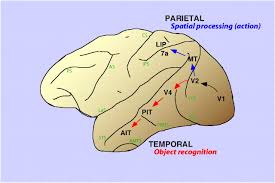Two areas in the visual cortex are associated with the perception of velocity, namely:
- The primary visual cortex (V1) and
- The middle temporal area (MT or V5).
Both V1 and MT contain neurons that respond strongly to motion in a particular direction and also have selective responses to a particular speed. Direction and speed together define the velocity vector, i.e., these V1 and MT neurons are velocity-tuned. The velocity tuned neurons in V1 typically project to velocity tuned cells in MT. While V1 harbors maroundcontains approximately 25% velocity-tuned neurons, those in the MT neurons are nearly all velocity-tuned (Bradley & Goyal, 2008).
Now this is all bottom-up processing. You basically ask as well whether top-down issues play a role. I do not think so. The visual system is basically split in a dorsal 'what' and a ventral 'where' stream (Fig. 1). The 'what' system identifies a target and the 'where' system (containing MT) determines location and velocity. As far as I know, there is no feedback from the dorsal stream onto the ventral one to affect velocity processing.

Fig. 1. Dorsal (parietal) and ventral (temporal) streams. source: Lehky & Sereno (2007)
References
- Bradley & Goyal, &Nature Rev Neurosci (2008); 9: 686-95
- Lehky & Sereno, *J Neurophysiol (2007); 97(1): 307-19